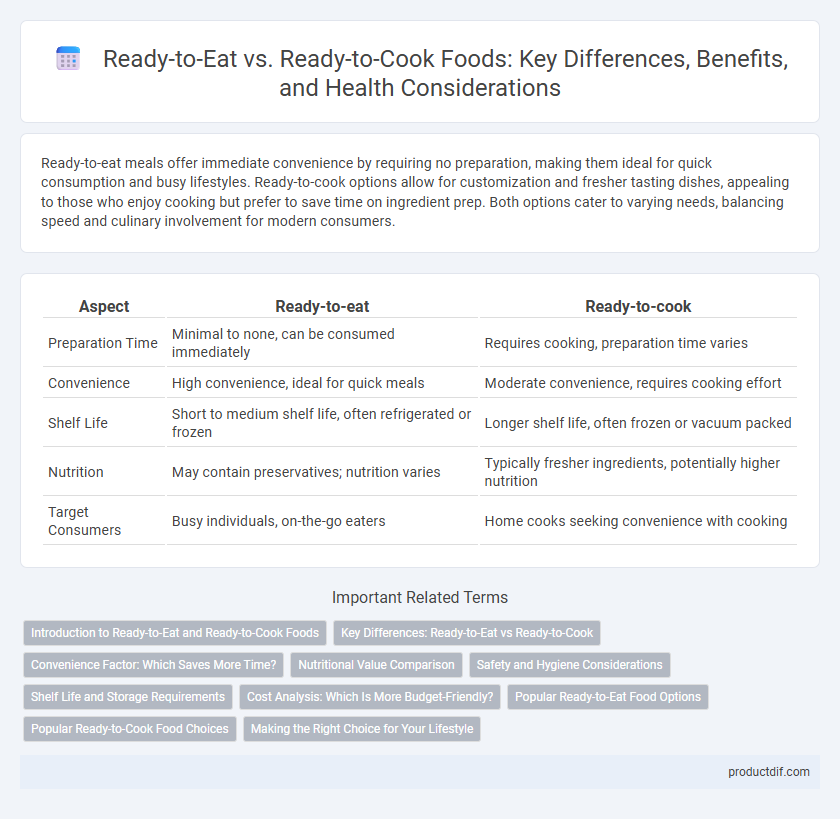Ready-to-eat meals offer immediate convenience by requiring no preparation, making them ideal for quick consumption and busy lifestyles. Ready-to-cook options allow for customization and fresher tasting dishes, appealing to those who enjoy cooking but prefer to save time on ingredient prep. Both options cater to varying needs, balancing speed and culinary involvement for modern consumers.
Table of Comparison
| Aspect | Ready-to-eat | Ready-to-cook |
|---|---|---|
| Preparation Time | Minimal to none, can be consumed immediately | Requires cooking, preparation time varies |
| Convenience | High convenience, ideal for quick meals | Moderate convenience, requires cooking effort |
| Shelf Life | Short to medium shelf life, often refrigerated or frozen | Longer shelf life, often frozen or vacuum packed |
| Nutrition | May contain preservatives; nutrition varies | Typically fresher ingredients, potentially higher nutrition |
| Target Consumers | Busy individuals, on-the-go eaters | Home cooks seeking convenience with cooking |
Introduction to Ready-to-Eat and Ready-to-Cook Foods
Ready-to-eat foods include pre-cooked meals, snacks, and packaged items that require no further preparation, offering convenience and immediate consumption. Ready-to-cook foods consist of raw or partially prepared ingredients that need cooking or heating before serving, balancing convenience with customization and freshness. Both categories cater to busy lifestyles, with ready-to-eat prioritizing speed and ready-to-cook focusing on meal quality and texture.
Key Differences: Ready-to-Eat vs Ready-to-Cook
Ready-to-eat foods require no further preparation and can be consumed immediately, offering convenience and time savings, while ready-to-cook products need additional cooking or heating before consumption, allowing for fresher taste and customization. Shelf life varies significantly; ready-to-eat foods often use preservation techniques such as vacuum sealing or refrigeration to maintain safety, whereas ready-to-cook items may rely on freezing or chilled storage to prolong freshness. Nutritional retention tends to be higher in ready-to-cook meals since they undergo less processing compared to fully prepared ready-to-eat options.
Convenience Factor: Which Saves More Time?
Ready-to-eat meals offer the highest convenience by eliminating preparation and cooking time, making them ideal for busy individuals seeking immediate consumption. Ready-to-cook products require minimal preparation but still involve cooking, saving time compared to from-scratch meals yet less than fully prepared options. Evaluating time savings, ready-to-eat meals consistently outperform ready-to-cook in convenience, especially for consumers prioritizing speed and ease.
Nutritional Value Comparison
Ready-to-eat meals often contain higher levels of sodium and preservatives to ensure longer shelf life, which can impact their nutritional quality compared to ready-to-cook options. Ready-to-cook foods typically retain more natural nutrients such as vitamins and minerals because they undergo minimal processing before preparation. Choosing ready-to-cook ingredients allows greater control over added fats and seasoning, supporting healthier dietary choices.
Safety and Hygiene Considerations
Ready-to-eat foods require strict adherence to hygiene standards during packaging to prevent contamination, as they are consumed without further cooking that would eliminate pathogens. Ready-to-cook products demand proper storage and handling to avoid bacterial growth before cooking, since thorough heat treatment is essential for safety. Both categories benefit from regulated temperature control and sanitary processing environments to minimize foodborne illness risks.
Shelf Life and Storage Requirements
Ready-to-eat food products typically have a shorter shelf life and require refrigeration or freezing to maintain freshness and prevent spoilage. Ready-to-cook items generally offer a longer shelf life due to preserved or frozen components but demand specific storage conditions such as freezing or refrigeration to ensure safety. Proper temperature control and packaging methods are critical factors influencing the shelf life and storage requirements of both food categories.
Cost Analysis: Which Is More Budget-Friendly?
Ready-to-eat meals typically cost more upfront due to convenience and packaging, while ready-to-cook options offer lower prices per serving and allow bulk purchasing of ingredients. Cost analysis reveals that ready-to-cook meals reduce expenses by minimizing preparation fees and enabling portion control, making them more budget-friendly. Consumers seeking long-term savings and culinary customization benefit most from ready-to-cook selections.
Popular Ready-to-Eat Food Options
Popular ready-to-eat food options include pre-packaged sandwiches, salads, and microwavable meals catering to convenience and quick consumption. These items are often found in grocery stores, convenience outlets, and vending machines, emphasizing portability and minimal preparation time. Consumers favor ready-to-eat foods for their time-saving benefits without sacrificing variety or taste.
Popular Ready-to-Cook Food Choices
Popular ready-to-cook food choices include marinated meats, pre-cut vegetables, and seasoned rice mixes that save preparation time while allowing customization. These options offer fresh ingredients with enhanced flavors, appealing to health-conscious consumers seeking convenience without sacrificing quality. Ready-to-cook meals also cater to diverse dietary preferences, supporting balanced nutrition and easy portion control.
Making the Right Choice for Your Lifestyle
Choosing between ready-to-eat and ready-to-cook meals depends on your daily schedule, cooking skills, and nutritional goals. Ready-to-eat options offer convenience and time savings, ideal for busy individuals seeking quick meals without preparation. Ready-to-cook products provide greater control over ingredients and freshness, making them suitable for those who enjoy cooking and prioritize customizable nutrition.
Ready-to-eat vs Ready-to-cook Infographic

 productdif.com
productdif.com